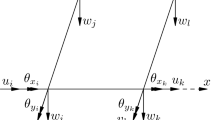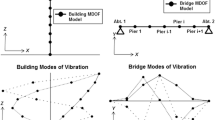Abstract
Based on the reduced set of base function in scaled boundary finite element method (SBFEM), an improved time domain numerical approach for the dynamic structure-foundation interaction analysis was proposed. With reasonable choice of the number of base functions, the degrees of freedom on the structure-foundation interface were reduced and the associated computation for the calculation of convolution integral was greatly reduced. The results of this proposed approach applied to the calculation of a gravity dam and an arch dam. The acceleration frequency response functions were calculated and the influences affected by different reduced set of base functions as well as full set were compared. It was found that a higher degree of reduced set of base functions resulted in a significant increase of computational efficiency but a little bit of loss in accuracy. When the reduced set was decreased by 60%, the efficiency may be increased to up to five times, while the loss of accuracy of peak value of response will be less than 4%. It may be concluded that the proposed approach is suitable for large-scale structure-foundation interaction analysis.
Similar content being viewed by others
References
Zhang C H Jin F, Pekau O A. Time domain procedure of FE-BE-IBE coupling for seismic interaction of arch dams and canyons. Earthquake Engineering and Structural Dynamics, 1995, 24: 1651–1666
Liu Yunhe, Zhang Boyan, Chen Houqun. Comparison of spring-viscous boundary with viscous boundary for arch dam seismic input model. Journal of Hydraulic Engineering, 2006, 37(6): 758–763 (in Chinese)
Wu Jian, Jin Feng, Zhang Chuhan, et al. Effects of radiation damping of infinite foundation on seismic response of the Xiluodu arch dam. Chinese Journal of Geotechnical Engineering, 2002, 24(6): 717–719 (in Chinese)
Song C M, Wolf J P. The scaled boundary finite-element method — alias consistent infinitesimal finite-element cell method — for elastodynamics. Computer Methods in Applied Mechanics Engineering, 1997, 147(3): 329–355
Yan J Y, Jin F, Zhang C H. A coupling procedure of FE and SBFE for soil-structure interaction in time domain. International Journal for Numerical Methods in Engineering, 2004, 59: 1453–1471
Du Jianguo, Lin Gao. Effect of foundation stiffness and anisotropy on the seismic response of concrete dams. Chinese Journal of Geotechnical Engineering, 2005, 27(7): 819–823 (in Chinese)
Doherty J P, Deeks A J. Application of the scaled boundary finite-element method to offshore foundation systems. In: Proceeding of the 12th International Offshore and Polar Engineering Conference. Kitakyushu, 2002
Song C M, Wolf J P. Semi-analytical representation of stress singularities as occurring in cracks in multi-materials with the scaled boundary finite-element method. Computers and Structures, 2002, 80 (2): 183–197
Deeks A J, Cheng L. Potential flow around obstacles using the scaled boundary finite-element method. International Journal for Numerical Methods in Fluids, 2003, 41(7): 721–741
Lin Gao, Du Jianguo. Analysis of dam-reservoir interaction based on SBFEM. Journal of Dalian University of Technology, 2005, 45(5): 723–729 (in Chinese)
Song C M. Weighted block-orthogonal base functions for static analysis of unbounded domains. In: Proceedings of the 6th World Congress on Computational Mechanics, Beijing, China, 2004, 615–620
Song C M. Dynamic analysis of unbounded domains by a reduced set of base functions. Computer Methods in Applied Mechanics and Engineering, 2006, 195(33–36): 4075–4094
Wolf J P, Song C M. Finite-Element Modelling of Unbounded Media. New York: Wiley, 1996
Du Jianguo, Lin Gao, Zhong Hong. The SBFEM model of three-dimensional unbounded foundation of arch dams based on cone theory. Water Resources and Power, 2006, 24(1): 25–29 (in Chinese)
Author information
Authors and Affiliations
Corresponding author
Additional information
__________
Translated from Shuili Xuebao, 2007, 38 (1): 8–14 [译自: 水利学报]
Rights and permissions
About this article
Cite this article
Du, J., Lin, G. Improved numerical method for time domain dynamic structure-foundation interaction analysis based on scaled boundary finite element method. Front. Archit. Civ. Eng. China 2, 336–342 (2008). https://doi.org/10.1007/s11709-008-0054-2
Published:
Issue Date:
DOI: https://doi.org/10.1007/s11709-008-0054-2




